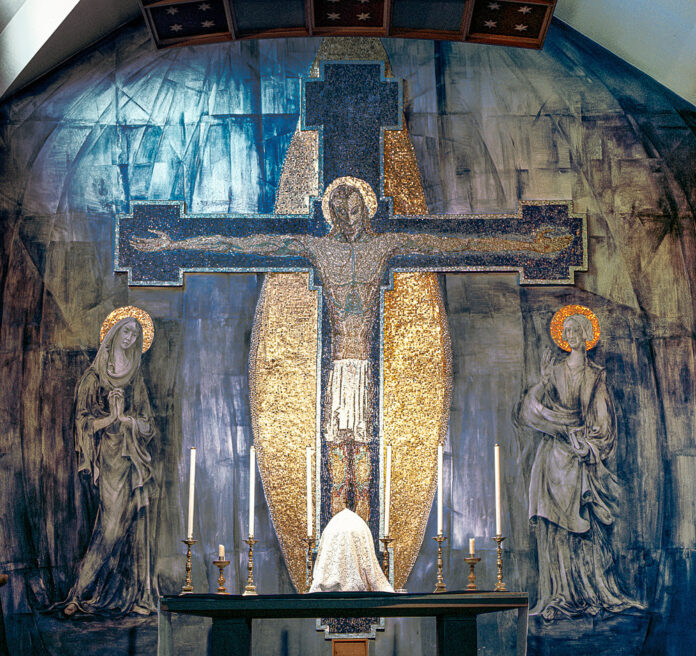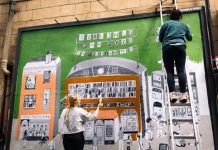The decision by the Department for Digital, Culture, Media & Sport (DCMS) on Historic England’s recommendation follows a long-running, high-profile campaign led by SAVE Britain’s Heritage and the artist’s great nephew Nick Braithwaite to stop the building being demolished and to save the mural in situ.
In its report recommending listing, Historic England gave a string of reasons relating to architectural and historic interest. It said: “The mural is highly unusual and possibly unique in this country in its striking aesthetic combination of neo-Baroque mosaic and modernist Cubist-influenced fresco inventively applied to traditional Christian iconography in a deeply personal evocation of suffering and redemption.”
It also praised “the transcendent spiritual nature of Christ […] heightened by the use of glittering mosaic for the figure and golden mandorla, contrasting with the figures of Mary and St John in earthbound, monochrome blue fresco”.
It added that it was “a major work in his oeuvre, much of which has been lost, the quality of execution and craftsmanship is superb, creating a piece of considerable power”.
The church, on the edge of Oldham, has been closed since 2017, leaving both building and mural vulnerable to decay and dereliction. In recent days the building has been subject to vandalism – so today’s decision has been urgently awaited.
The Oldham Mural, praised by V&A director Tristram Hunt for its “dazzling beauty”, was created by visionary Hungarian artist George Mayer-Marton in 1955 using a rare combination of mosaic and fresco.
SAVE strongly backed the listing application made in August 2020 by the artist’s great nephew which contained new information by conservators about the quality of the fresco surviving beneath a partial 1980s overpainting, as well as statements from eminent art historians and strong support from the Twentieth Century Society.
We also galvanised support from galleries and museums that hold works by Mayer-Marton including the Victoria Gallery in Liverpool and the Glynn Vivian Gallery in Swansea as well as the Imperial War Museum.
We also secured direct support from the directors of world-famous art museums including Tristram Hunt at the Victoria & Albert Museum and Gabriele Finaldi at the National Gallery in London, László Baán at Budapest’s Museum of Fine Arts and Harald Krejci at the Belvedere in Vienna.
At a joint SAVE & Twentieth Century Society event earlier this year, Clare A.P. Willsdon, Professor of the History of Western Art at Glasgow University, explained the mural’s historical context and argued it should be considered a “Gesamtkunstwerk” – or Total Work of Art – because of the significance of its positioning within the church and the other sacred artworks it contains.
Henrietta Billings, director of SAVE Britain’s Heritage, says: “This is a fantastic result for Oldham, and modern public art in England. We’re delighted that the mural will now be celebrated and finally given the recognition it deserves. Listing will open up a new chapter for this building and artwork and we look forward to helping the Diocese of Salford to find a new and sympathetic owner.”
Marcus Binney, executive president of SAVE Britain’s Heritage, says: “The listing averts the possible loss of a major religious work which has been causing huge concern in the art world and beyond.”
Nick Braithwaite, great nephew of George Mayer-Marton, says: “I am delighted this masterpiece of exceptional significance is finally receiving the national recognition it deserves. I am grateful to everyone who has helped get us here and especially to SAVE Britain’s Heritage for keeping the mural in the spotlight.”







